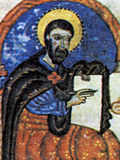Vardan Areveltsi
Vardan Areveltsi | |
|---|---|
| Born | c. 1198 |
| Died | 1271 |
| Other names | Vardan Mec[1] |
| Education | Goshavank,Khornashat Monastery |
| Occupation(s) | Historian,geographer,philosopher |
| Known for | Historical Compilation |
Vardan Areveltsi(Armenian:Վարդան Արևելցի;Vardan the Easterner,c. 1198– 1271AD) was a thirteenth-centuryArmenianhistorian,geographer,philosopherandtranslator.[2]In addition to establishing numerous schools and monasteries, he also left behind a rich contribution to Armenian literature.[3]He is well known for writingHavakumn Patmutsyun(Historical Compilation), one of the first ever attempts to write a history of the world by an Armenian historian.
Biography[edit]
Early life[edit]
Vardan was born in Gandzak in 1198. He received his education at a school in Gandzak and at Nor Getik Monastery (later known asGoshavank), where he was student of the prominent scholarMkhitar Gosh.He continued his studies at the Khornashat monastery inTavush,learningliterature,grammar,andtheology.He also learned several languages while at Khornashat, masteringHebrew,Greek,LatinandPersian.[3]In 1235, Vardan became avardapetand put his experience in education into action: he opened a school at St. Andre monastery in Kayenaberd and taught there from 1235 to 1239 and from 1252 to 1255. In 1239, he left Armenia forJerusalemand on his return journey, traveled through theArmenian Kingdom of Cilicia,where he was a guest in the royal court ofHet'um I.He remained in Cilicia long enough to participate in the 1243ecumenical councilin the capital atSis.[3]Vardan returned home in 1245, bringing along with him the canon laws that were decided upon at Sis.
Educational and ecclesiastical activity[edit]

Three years later, Vardan traveled to the Cilician Armenia once more, this time participating in the governmental and social affairs of the kingdom. He was a fierce opponent of what he saw as the encroachment of theEastern OrthodoxByzantineandCatholicchurches in Cilician Armenia and fought diligently to counter their influences.[3]While in Cilicia, Vardan also worked withCatholicosConstantine Bardzraberdtsito write an ecclesiastical treatise entitled "Didactic Paper", which was intended for use in eastern Armenia. His religious activities also included writing a letter to thePopein regards to the latter's attempts to extendCatholicismin the kingdom and his participation in another ecumenical council in 1251 in Sis.
In 1252, Vardan returned to Armenia and began organizing an ecumenical council that would convene inHaghpatand Dzagavan. Returning to educational life, he also established institutions for learning at the monasteries ofSaghmosavank,Teghenyats, Aghjots, and Khorakert. He remained an instructor at Haghpat for several years until 1255, when he traveled toKhor Virap,establishing aseminarythere.[3]At Khor Virap, he introduced a curriculum which includedphilosophy,logic,oratory,andgrammar.Many of his pupils went on to become notable Armenian intellectuals, including Gevork Skevṛatsi, Hovhannes Yerznkatsi, Nerses Mshetsi, and Grigor Bjnetsi.[3]In 1264, Vardan also played an important role as a negotiator when he went toTabriz,where theMongolleaderHulagu Khanwas residing. He brokered an agreement which gave special privileges to the Armenians living under the yoke of the Mongol Empire and settled a deal on the collection of levies and taxes. Vardan's ties with the Mongols were especially intimate, as he was allowed to become the religious adviser of Hulagu Khan's wife,Doquz Khatun,who happened to be aNestorian Christian.[4]
Vardan died in 1271 in Khor Virap, bequeathing a significant literary legacy which encompassed Armenia's political, cultural, religious, and social lives.[3]
Works[edit]
Over 120 works attributed to Vardan Areveltsi have been preserved.[3]Among his most significant works is a 66 item collection calledLutsmunk i Surb Grots(better known asZhghlank,orChats), which was written at the request of King Het'um I.[5]It is written in the vernacular tongue, making it easily comprehensible and concerns itself with many questions related to the nature of life (nature, the formation of celestial bodies,astronomy,botanyandzoology,language,philosophical questions revolving around man, music, etc.).[3]For example, a critical observation Vardan makes in this work is his expression in the belief that, "nothing outside of nature moves nor stops; motion is not solely the movement of one place to another, but an inner transformation which moves from one state to another."[3]
However, Vardan's most important work is hisHavakumn Patmutsyun(Historical Compilation). Much likeMovses Khorenatsi'sHistory of Armenia,Havakumn Patmutsyunis an attempt to trace Armenian history from its beginnings to the present day. But the work is also significant for attempting to document the history of the entire world. Starting with theTower of Babeland the epic battle betweenHaykandBel,the history ends with the death of Constantine I Bardzraberdtsi's death in 1267.[3]It is, however, considered more achronicle,rather than the histories written by traditional Armenian authors.[6]
Vardan also translated many foreign works into Armenian. One of the most significant wasMichael the Syrian'sChronicletranslation in 1248. Other translated works included conversations and works on philosophy, theology, which were translated from Greek, Latin, andSyriac.[3]
Below is a partial list of his works, many of which, including facsimiles, are currently preserved at theMatenadaraninYerevan,Armenia.[3]
- Ashqharatsuyts(Geography)
- Lutsmunk i Surb Grots(also known asZhghlank)
- Havakumn Patmutsyun(Historical Compilation)
- Vark' Zardaretsin(Those who embellished)
References[edit]
- ^Robert W. Thomson. Vardan Arevelc'i // Christian-Muslim Relations. A Bibliographical History. (1200-1350) / Edited by David Thomas and Alex Mallett. — BRILL, 2012. — Vol. 4. — P. 444 "Vardan was known as Arevelc'i ('from the East'), or Mec ('great') to distinguish him from numerous other Vardans."
- ^The Cambridge History of Iran / Edited by J. A. Boyle. —Cambridge University Press,1968. — Vol. 5. — p. 42.: "The 7th/13th-century Armenian historian Vardan calls Toghril "leader of the Doger", another Oghuz tribe, who, unlike the Qiniq, did play a significant role in northern Iran"
- ^abcdefghijklmHovhannisyan, Petros.«Վարդան Արևելցի»(Vardan Areveltsi).Armenian Soviet Encyclopedia.vol. xi. Yerevan:Armenian Academy of Sciences,1985, pp. 312-313.(in Armenian)
- ^Lane, George E. (2003).Early Mongol Rule in Thirteenth-Century Iran: A Persian Renaissance.London: Routledge. p.13.ISBN0-415-29750-8.
- ^Hacikyan, Agop Jack, Gabriel Basmajian, Edward S. Franchuk, and Nourhan Ouzounian (2002).The Heritage of Armenian Literature, Vol. 2: From the Sixth to the Eighteenth Century.Detroit: Wayne State University, p. 486.ISBN0-8143-3023-1.
- ^Hacikyan et al.Heritage of Armenian Literature,p. 487.

